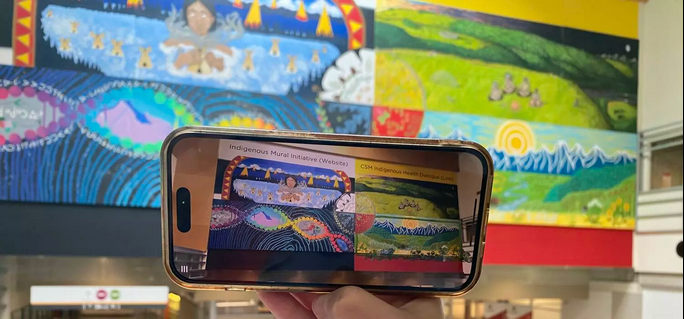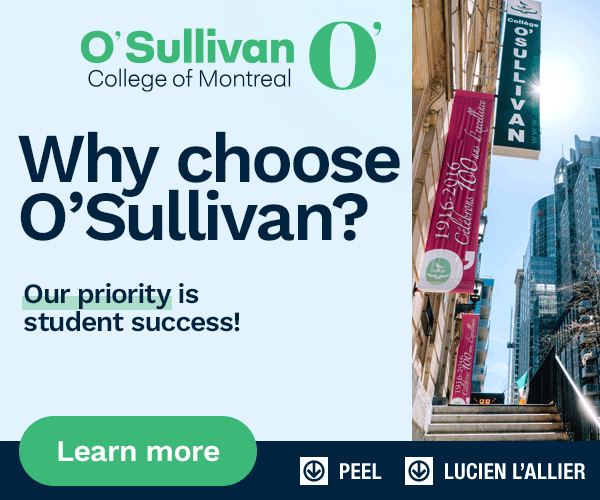
Photo Credit: Rachel Braeuer
Through the lens of your smartphone, a new augmented reality (AR) art exhibit brings to life a large colourful mural created by local Indigenous artists.
Crowning the Health Sciences Centre atrium on the University of Calgary's Foothills campus, the striking visuals hold untold and deeply meaningful stories that are now digitally accessible thanks to two alumni of the Cumming School of Medicine, Arzina Jaffer, BHSc'22, and Laine Grace, BSc'21, and the work of the Urban Society of Aboriginal Youth (USAY).
The mural helps bring Indigenous perspectives into the educational space. It was officially unveiled in 2022 in a sacred ceremony hosted by Elders. It was created by Indigenous artists from the Treaty 7 region and tells a story of traditional Indigenous medicines through the seasons, panel representing the treaty signatories, along with the Métis Nation of Alberta.
Rich with symbolism, the mural's full story may not be obvious to everyone. With this in mind, Jaffer and Grace, supported by Dr. Aleem Bharwani, MD, director of public policy with the CSM's Indigenous, Local, and Global Health Office, used part of the UCalgary Students' Association's Quality Money Program to support this project. Quality Money allows the campus community to access financial support for creating and implementing projects and initiatives identified as priorities by students. These funds allowed the group to engage with USAY to create an AR feature to tell the stories behind the mural, and a qualitative research project about the impact of Indigenous art in a medical education setting. The mural's creation was also supported with funds from Calgary Arts Development.
"We've heard a lot of people say that it makes the space brighter and more interesting. We have also heard from students including Indigenous students about how it makes the space more inclusive. How they're able to sit, connect and reflect in times of stress or when they need to ground themselves," says Laine, a member of the Métis Nation of B.C.
The mural symbolizes CSM's commitment to the Indigenous Health Dialogue (IHD), a series of recommendations published in 2020 to enhance existing initiatives within the faculty, create new opportunities for programming and thoughtfully respond to the Truth and Reconciliation Commission Calls to Action.
"At the heart of the mural project is an institutional commitment to promoting dialogue and shared understanding," says Bharwani. "It doesn't mean that we need to agree but that we seek to understand. In this way, the mural represents a dedicated, inviting space in which to activate our curiosities and nurture relationships with people and peoples so that, over time, conflict is replaced with context, and attitudes, behaviours and policies incorporate that shared understanding."
Accessible through an app on any mobile device, the mural's AR component features the artists describing the intention and stories behind their work. Elder Reg Crowshoe, Hon. LLD'01, wrote a song to help tell the story of the Winter panel of the mural. The oral storytelling is paired with animations applied throughout the mural.
"Indigenous cultures have long passed on knowledge from generation to generation through oral traditions and storytelling. I think AR is the best medium we could have used to share the stories behind the art, while honouring these historic storytelling and oral traditions," says Jaffer.
USAY strives to provide essential programming and services to Calgary's Indigenous youth ages 12 to 29. The group produces an AR magazine, New Tribe, that is available in the Indigenous Hub at the CSM's Indigenous Local and Global Health office, located steps away from the mural. IndigiPRINTS, the program that creates the AR features, was inspired by a trip to an arcade with a group of youth and has now produced more than 100 AR projects.
It's an important collaboration, and having Indigenous teachings on medicine represented at the school is meaningful, says USAY executive director, LeeAnne Ireland. "Many people walking the halls of Foothills campus will see the mural, reflecting the seasons, bloodlines and trees, and wonder, What does this have to do with medicine?'" Ireland says. "It provokes a conversation about what medicine is and what role tradition, seasons and connection to land play in it. It's really inspired."
The mural is featured in the documentary Reconciliation Through Art, created by Métis filmmaker Sean Smith, who says the documentary helps shine a light on the inspiration behind the mural and the dialogue it facilitates between Western and Indigenous medicine. "It showcases the collaboration between the artists, students and faculty that happened behind the scenes, facilitates conversations about the themes within the mural, and shows how technology can engage people in discussions around topics like truth and reconciliation," says Smith. The documentary recently screened as part of the Science in the Cinema series at the Central Library.
Aleem Bharwani, MD, is a physician and associate professor in the departments of Medicine and Community Health Sciences at the Cumming School of Medicine (CSM). He is the founding director of the University of Calgary's Pluralism Initiative, Vice- President Research Office, and director, Public Policy and Partnership, CSM's Indigenous, Local and Global Health Office (ILGHO). He is a member of the CSM's O'Brien Institute for Public Health, where he is policy and partnerships lead. He is a member of the Alberta Children's Hospital Research Institute and the inclusive governance lead of One Child Every Child.
ILGHO facilitates education, research and engagement efforts that build health equity at home and abroad, and draws from experience to offer best-evidence resources that enable students, staff and faculty to pursue community-driven solutions that address social and health disparities. ILGHO's commitment is to collaborate with communities to address the barriers that create health and social disparities; and, through this engagement, co-foster solutions that change inequitable conditions, systems and policies.
The Urban Society for Aboriginal Youth has been an influential not-for profit organization in Calgary since 2001. USAY strives to provide essential programming and services to Calgary's Indigenous youth between the ages of 12 and 29.
The University of Calgary's Indigenous Strategy, ii' taa'poh'to'p, is a commitment to deep evolutionary transformation by reimagining ways of knowing, doing, connecting and being. Walking parallel paths together, "in a good way," UCalgary is moving toward genuine reconciliation and Indigenization.













